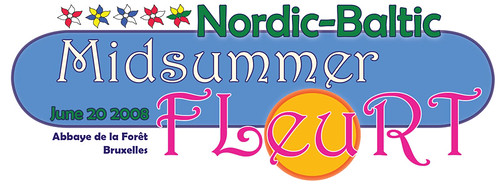 The Danish midsummer celebrations are a mix of different traditions that have been blended into a distinct Danish cocktail. On Midsummer's Eve, which is always on the 23rd of June, we celebrate Skt. Hans, Saint John the Baptist. The event itself though is not very Christian. The Midsummer celebrations are, as you might now know, an ancient practice dating back to pre-Christian times, where the long days and nights were the centre of attention and worship.
The Danish midsummer celebrations are a mix of different traditions that have been blended into a distinct Danish cocktail. On Midsummer's Eve, which is always on the 23rd of June, we celebrate Skt. Hans, Saint John the Baptist. The event itself though is not very Christian. The Midsummer celebrations are, as you might now know, an ancient practice dating back to pre-Christian times, where the long days and nights were the centre of attention and worship.Usually you will invite friends over for a barbecue and around 9pm you go to the bonfire. First there should be a speech. Local, national, and even MEP's take time off to give speeches to the participants of the midsummer bonfires. They talk about the state of the country, about democracy, or about how we live together. Even though the constitution day is on the 5th of June, the eve of Skt. Hans is probably the day of the year where we feel the most patriotic.
After the speech we burn the witch. Big bonfires are part of the Nordic and Baltic practices, but in Denmark we have added the German tradition of burning a witch on the bonfire. She is made out of wood, paper and old clothes, and sometimes she is also stuffed with the fireworks called Heksehyl (Witch's Cry) that make a very distinct sound. She is said to fly off to the mountain of Bloksbjerg in Germany
to meet with the other witches.
On top of that we celebrate our little country by singing the patriotic song of Skt. Hans about how everything is blooming in Denmark and how we want to protect the country from witches and trolls and all other evils of the world that want to disturb the peace. Usually if you live by the water, you go to the nearest beach for the bonfire. On clear nights you can see all the fires along the coast for miles, which is very beautiful.
Even though The Danes have stolen many traditions from other countries and have moved the celebrations from the longest day (June 21st) to June 23rd in honor of Christianity, we still feel that it is a distinct Danish tradition, especially when we sing the Midsummer Song written by the poet Holger Drachmann.
You can find the tune here: http://youtube.com/watch?v=KKjuBJj2_m0
 Vi elsker vort land,
Vi elsker vort land,når den signede jul
tænder stjernen i træet med glans i hvert øje,
når om våren hver fugl
over mark, under strand
lader stemmen til hilsende triller sig bøje,
vi synger din lov over vej, over gade,
vi kranser dit navn, når vor høst er i lade,
men den skønneste krans
bli'r dog din sankte Hans,
den er bunden af sommerens hjerter så varme, så glade,
men den skønneste krans
bli'r dog din sankte Hans,
den er bunden af sommerens hjerter så varme, så glade.
Vi elsker vort land,
men ved midsommer mest,
når hver sky over marken velsignelsen sender,
når af blomster er flest,
og når kvæget i spand,
giver rigeligst gave til flittige hænder,
når ikke vi pløjer og harver og tromler,
når koen sin middag i kløveren gumler,
da går ungdom til dans
på dit bud sankte Hans
ret som føllet og lammet der frit over engen sig tumler,
da går ungdom til dans
på dit bud sankte Hans
ret som føllet og lammet der frit over engen sig tumler.
Vi elsker vort land
og med sværdet i hånd
skal hver udenvælts fjende beredte os kende,
men mod ufredens ånd
over mark, under strand
vil vi bålet på fædrenes gravhunde tænde,
hver by har sin heks, og hvert sogn sine trolde,
dem vil vi fra livet med glædesblus holde,
vi vil fred her til lands,
sankte Hans, sankte Hans,
den kan vindes, hvor hjerterne aldrig bli'r tvivlende kolde,
vi vil fred her til lands,
sankte Hans, sankte Hans,
den kan vindes, hvor hjerterne aldrig bli'r tvivlende kolde.



No comments:
Post a Comment